Table of Contents
ToggleGreek Food for Personal Chefs
As personal chefs, our culinary journey takes us around the globe, exploring different cuisines and flavors. Today, we are venturing into the heart of the Mediterranean to explore the flavorful and wholesome world of Greek cuisine. With its rich history and vibrant culture, Greece is known for its delicious and healthy food that has stood the test of time.
Greek cuisine is all about fresh, seasonal ingredients, simple preparation techniques, and a strong focus on olive oil, vegetables, grains, fish, and lean meats. The use of herbs and spices adds depth and complexity to dishes while still keeping them light and flavorful. Whether you are catering to clients with dietary restrictions or simply looking for nutritious meals that will please everyone’s taste buds, Greek food should definitely be on your menu rotation.
Aspiring personal chefs need to offer something different than traditional chefs who specialize in one or two kinds of cuisines. I’ve written an extensive article with links to many cuisines for your consideration – World Cuisine for Personal Chefs
Key Ingredients in Greek Cuisine
Greek cuisine is characterized by its use of fresh, local ingredients that reflect the country’s agricultural heritage. Some of the key ingredients include olive oil, lemons, honey, oregano, thyme, bay laurel leaves, feta cheese, olives, and a variety of vegetables like tomatoes, cucumbers, and bell peppers. These ingredients are not only essential to the flavor of Greek dishes, but they also provide numerous health benefits.
Olive oil is a staple in Greek cooking and is used in almost every dish. It is rich in monounsaturated fats, which have been linked to lowering cholesterol levels and reducing the risk of heart disease. The high quality extra virgin olive oil is often used as a finishing touch on salads or drizzled over grilled vegetables.
Lemons are another key ingredient in Greek cuisine and are used for both their juice and zest. They add a bright, tangy flavor to dishes like souvlaki (grilled meat) and tzatziki (yogurt dip). Lemons are also high in vitamin C, which can boost the immune system and promote healthy skin.
Herbs and spices are essential in creating the unique flavors of Greek dishes. Oregano, thyme, and dill are commonly used in savory dishes, while cinnamon and nutmeg add warmth to sweet treats like baklava. These herbs and spices not only enhance the taste of food, but they also have numerous health benefits. For example, oregano contains antioxidants that can help boost the immune system and fight inflammation.
Feta cheese is a beloved ingredient in Greek cuisine and is often crumbled on top of salads or used as a filling in spanakopita (spinach pie). It is made from sheep’s milk, which is higher in protein than cow’s milk. Feta cheese also provides calcium and phosphorus, essential minerals for strong bones and teeth.
Greek yogurt is another staple in Greek cooking. It is thicker and creamier than regular yogurt due to the straining process, which removes excess liquid. This also means that Greek yogurt has a higher protein content than regular yogurt. It is often used as a base for dips or sauces and can be substituted for sour cream or mayonnaise in recipes.
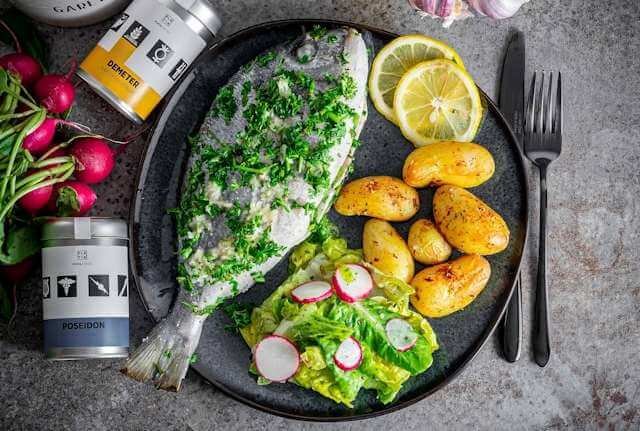
Sourcing Ingredients Locally
While many of these ingredients can be found in local supermarkets, some might require a visit to a specialty Mediterranean grocery store. If certain ingredients are not available locally, suitable substitutes can often be found.
For instance, you could substitute fresh oregano with dried oregano. You can also grow some of these ingredients in your own backyard, such as herbs like mint and parsley.
Sourcing ingredients locally not only supports your local community, but it also ensures the freshest and most nutritious meals. By purchasing from local farms and markets, you are reducing the carbon footprint associated with transporting food long distances. Plus, you have the opportunity to connect directly with farmers and learn about their growing practices.
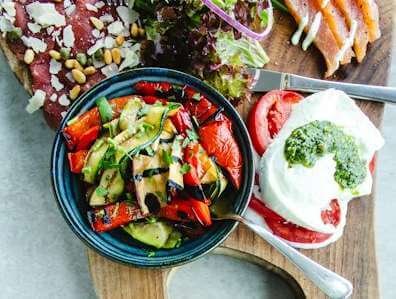
Traditional Cooking Methods
Greek cuisine employs a variety of cooking methods, including grilling (for dishes like souvlaki), baking (for dishes like moussaka), sautéing, and stewing. These methods have been used for centuries and are still prevalent in modern Greek cooking.
Grilling is a popular method of cooking in Greece, especially during the summer months. Traditionally, skewered meats like souvlaki (marinated pork or chicken) are cooked over an open flame until they are juicy and charred on the outside. This imparts a smoky flavor to the meat that is beloved by Greeks and tourists alike.
Baking is another common cooking method in Greek cuisine. The most famous dish that uses this technique is moussaka, which consists of layers of eggplant, ground meat, and creamy béchamel sauce. The dish is baked until it becomes golden brown and bubbly, creating a delicious combination of flavors and textures.
Other baked dishes, such as spanakopita (spinach and feta pie) and tiropita (cheese pie), are also popular in Greek households.
Stewing and braising are also frequently used cooking methods in Greece. These techniques involve slowly simmering meats, vegetables, and herbs in a flavorful liquid until they become tender and infused with flavor. One well-known dish that utilizes this method is stifado, a hearty beef stew cooked with onions, tomatoes, and red wine.

Dominant Flavors of Greek Cuisine
Greek cuisine is known for its bold, robust flavors with a balance of tangy, sweet, and savory elements. The dominant flavors come from the liberal use of herbs, citrus, and olive oil. These ingredients are staples in Greek cooking and contribute to the vibrant and fresh taste of the dishes.
Herbs such as oregano, thyme, and rosemary are commonly used in Greek cuisine. They add depth and complexity to dishes while infusing them with a distinctive Mediterranean aroma. In traditional Greek cooking, herbs are often used in combination rather than individually to create a harmonious blend of flavors.
Citrus fruits, particularly lemons, also play a crucial role in Greek cuisine. Lemon juice is used as a marinade for meats or as an acidic element in sauces and dressings. The zest of lemon adds brightness and tanginess to dishes, making them more refreshing.
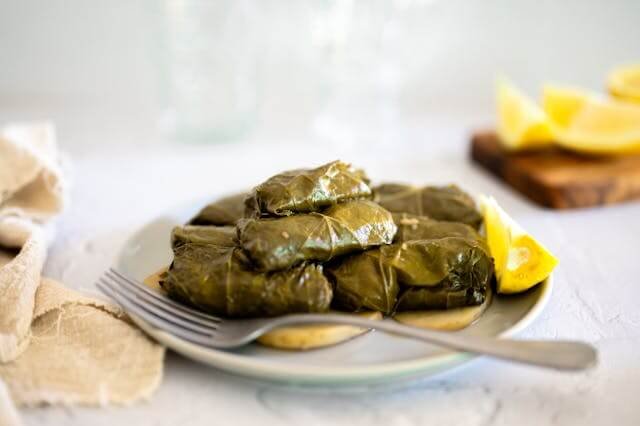
Spice Level Adjustment
While Greek cuisine is not typically spicy, some dishes may contain a bit of heat from spices like paprika or chili flakes. The spice level can usually be adjusted to suit your client’s preference by using less of the spicy ingredient or eliminating it altogether.
Cultural Significance of Greek Cuisine
Greek cuisine has a rich history dating back to ancient times. Meals are often seen as a time for family gatherings and celebrations. Many dishes have a story behind them that reflects the history and culture of Greece. Let’s take a closer look at the cultural significance of Greek cuisine.
Geography
The geographical location of Greece has had a major influence on its cuisine. With its access to the Mediterranean Sea, the country has an abundance of fresh seafood that is incorporated into many dishes. The warm climate also allows for a variety of fruits and vegetables to be grown, which are widely used in traditional Greek dishes.
Heritage and Traditions
Greek cuisine is deeply rooted in heritage and traditions. Recipes have been passed down from generation to generation, with each family adding their own unique touch. Meals are often prepared with great care and attention to detail, showcasing the importance placed on food in Greek culture.
Symbolism
Many dishes in Greek cuisine hold symbolic meaning. For example, the pomegranate is often used in dishes during special occasions such as weddings or New Year’s celebrations. Its many seeds are seen as a symbol of abundance and fertility. Another common symbol is the olive tree, which represents peace and prosperity.
Mediterranean Diet
The traditional Greek diet is often referred to as the Mediterranean diet, which has gained recognition for its health benefits. This diet consists mainly of whole grains, vegetables, fruits, legumes, and olive oil. It also includes moderate amounts of dairy, fish, and poultry. Red meat is consumed sparingly.

Dietary Considerations
When preparing Greek cuisine, it’s important to consider dietary restrictions. Many Greek dishes are inherently vegetarian or vegan-friendly, and gluten-free options are also available.
However, it’s always best to communicate any allergies or dietary restrictions with your personal chef beforehand.
Vegetarian and Vegan Options
Greek cuisine is known for its fresh and flavorful vegetarian dishes. Traditional Greek salads, stuffed grape leaves (dolmades), and dips like hummus and tzatziki are all great options for those following a vegetarian or vegan diet. For a heartier meal, try the popular spanakopita – a savory pie filled with spinach and feta cheese.
Gluten-Free Choices
For those who cannot consume gluten, there are still plenty of delicious options to enjoy in Greek cuisine. Many traditional dishes use rice or potatoes as a base instead of wheat products. Some examples include moussaka, which is made with layers of eggplant, potatoes, and a meat sauce, and souvlaki skewers made with marinated chicken or lamb. You can also request gluten-free pita bread to be served alongside your meal.
Health Considerations
Greek cuisine, like many other Mediterranean cuisines, is considered healthy due to its emphasis on fresh fruits and vegetables, whole grains, lean proteins, and heart-healthy fats from olive oil and nuts. This makes it a great option for those looking to maintain a healthy diet.
However, there are still some health considerations to keep in mind when indulging in Greek dishes.
One of the main concerns is the amount of salt used in traditional Greek cooking. Many dishes, such as souvlaki and feta cheese, can be high in sodium which can contribute to high blood pressure and other health issues. It’s important to be mindful of the salt intake and try to limit the consumption of these higher-sodium foods.
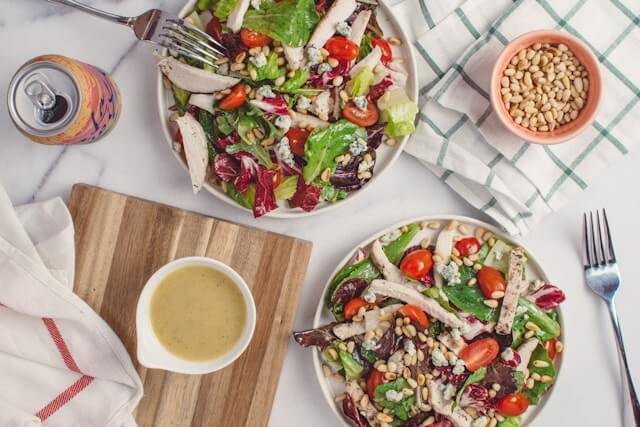
Traditional Accompaniments
A traditional Greek meal often includes a variety of meze (small dishes), a salad, a main dish of meat or fish, and a dessert like baklava. Wine or ouzo, an anise-flavored liquor, are commonly served with meals.
Here are some traditional accompaniments that you may find in a Greek meal:
1. Tzatziki
Tzatziki is a popular Greek dip made with yogurt, garlic, cucumber, and olive oil. It’s often served as an appetizer or condiment for meat dishes.
2. Hummus
Hummus, a spread made from chickpeas, tahini, lemon juice, and garlic, is also commonly found in Greek cuisine. It can be enjoyed as a dip with pita bread or used as a topping for gyros.
3. Dolmades
Dolmades are stuffed grape leaves filled with rice and herbs such as dill and mint. They can be served cold as an appetizer or warm as a side dish.
4. Greek Salad
A classic Greek salad consists of tomatoes, cucumbers, red onions, feta cheese, and olives dressed in olive oil and oregano. It’s a refreshing addition to any meal.
5. Spanakopita
Spanakopita is a savory pie made with layers of phyllo dough, spinach, feta cheese, and herbs. It’s a delicious vegetarian option and can be served as an appetizer or main dish. This dish is also commonly found in other Mediterranean cuisines such as Turkish and Lebanese.
6. Moussaka
Moussaka is a traditional casserole dish made with layers of eggplant, ground meat (typically lamb), and topped with a creamy béchamel sauce. It’s a hearty and comforting dish that is often served for special occasions.
7. Baklava
Baklava is a sweet and indulgent dessert made with layers of phyllo dough, chopped nuts, and honey syrup. It’s a staple in Greek cuisine and can be found in different variations across the Mediterranean.
8. Gyro
A gyro is a popular street food in Greece made with grilled meat (usually lamb or chicken), tzatziki sauce, tomatoes, onions, and sometimes french fries all wrapped up in a warm pita bread. It’s a delicious option for a quick meal on-the-go.
9. Souvlaki
Souvlaki is another popular Greek dish consisting of grilled meat (typically pork or chicken) on skewers served with vegetables, pita bread, and tzatziki sauce. It’s a simple yet flavorful meal that’s perfect for a summer BBQ or a quick weeknight dinner.
Presentation
In Greek cuisine, the presentation is simple yet appealing, with an emphasis on the fresh ingredients themselves rather than elaborate garnishes.
Common Variations
Greece’s diverse regions each have their unique flavors and dishes. For example, the island of Crete is known for its use of wild greens and cheese, while Macedonia is famous for its spicy dishes.
Thessaly is known for its use of beans and legumes, while the Peloponnese region is known for its delicious olive oil. These variations in cuisine are a result of the country’s rich history and geographical diversity.
History
Greek cuisine has been influenced by various cultures throughout history, including ancient Greek, Roman, Byzantine, and Ottoman empires. The ancient Greeks were known for their love of food and believed that eating well was essential to a healthy body and mind.
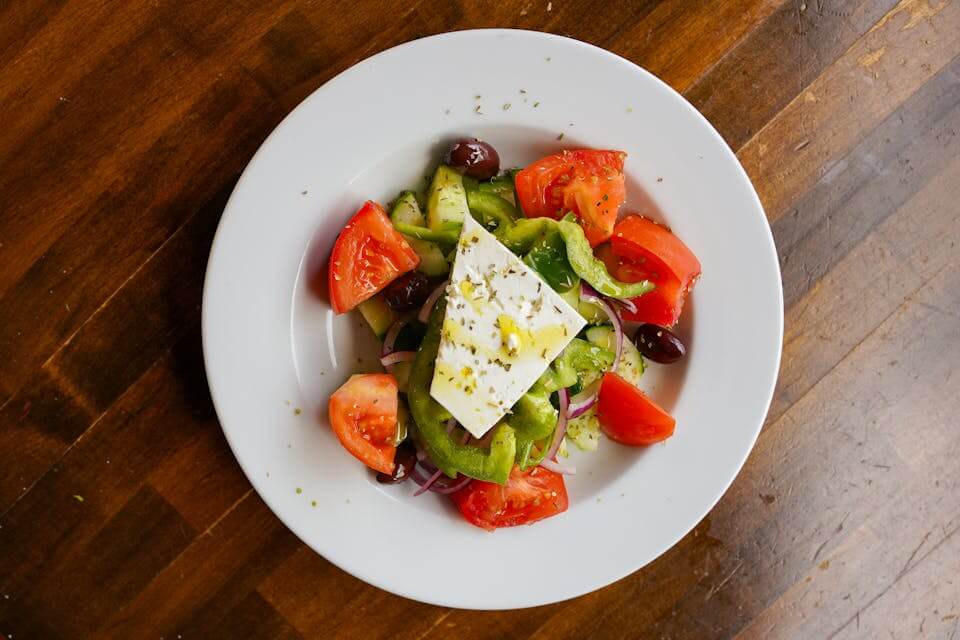
Preparation and Equipment
Some Greek dishes may require specific equipment, like a grill for souvlaki. Certain elements of a dish, like marinated meats or phyllo dough for pastries, may need to be prepared ahead of time.
Here are some of the most common tools, utensils, pots, and pans you might use when preparing Greek cuisine:
A small frying pan used for preparing Greek dishes like saganaki, a fried cheese appetizer.
This small, long-handled pot is used to make traditional Greek coffee.
Essential for roasting meats and vegetables, common in Greek cuisine.
A deep baking dish used for making moussaka, a layered eggplant and meat dish.
Used for sautéing and frying foods, such as Greek sausage or seafood.
A good quality, sharp chef’s knife is necessary for precise cutting and slicing of ingredients.
A sturdy cutting board is needed for preparing ingredients.
An essential tool for grinding spices and herbs, which are used frequently in Greek cooking.
Essential for serving soups and stews.
For accurate measurement of ingredients.
Handy for turning and handling food, especially when frying or grilling.
A handy tool for extracting juice from lemons, which are frequently used in Greek cooking.
For everything from roasting vegetables to baking pastries.
Great for stirring and doesn’t react with acidic ingredients.
Useful for separating solids from liquids when making broths or sauces.
Remember, investing in high-quality tools can greatly enhance your cooking experience and the outcome of your dishes. Keep them well-maintained for the best results.
Wondering what tools a personal chef might need? I’ve written an extensive article for you – A Comprehensive List Of Must-Have Tools and Essential Items for the Personal Chef
Personalizing Greek Cuisine
Personalizing Greek dishes while maintaining authenticity can be achieved by adjusting flavors to suit personal preferences, substituting ingredients based on dietary needs, or presenting dishes in creative ways. With a rich history and diverse flavors, Greek cuisine offers endless possibilities for customization.
One way to personalize Greek dishes is by adjusting the level of seasoning and spices used. Some individuals may prefer a bolder, spicier taste while others may prefer milder flavors. By experimenting with different amounts of herbs and spices, such as oregano, thyme, and garlic, each dish can be tailored to suit individual taste buds.

Greek Food for Personal Chefs
Exploring and cooking Greek cuisine offers a rewarding culinary journey. By understanding its key ingredients, techniques, and cultural significance, we can bring the authentic taste of Greece to our clients’ dining tables.
As personal chefs, it is our duty to cater to the diverse tastes and dietary requirements of our clients, and Greek food offers a delicious and healthy option.
Here are some of my favorite tools for providing my personal chef service
As an experienced personal chef, I’ve found that the secret to creating mouthwatering dishes goes beyond just having a passion for food. It’s also about using the right kitchen tools. Today, I’m going to share with you my must-have kitchen items that help me bring my culinary creations to life.
1. Chef’s Knife
The first item on my list is a high-quality chef’s knife. It’s the most versatile tool in my kitchen, perfect for chopping, slicing, and dicing. My preference is for a Global Chef’s Knife, known for the edge and the way they are balanced.
2. Cast Iron Skillet
Next up is a good old cast-iron skillet. From searing steaks to baking cornbread, this pan does it all. I love the Lodge Cast Iron Skillet, which retains heat beautifully and adds a nice crust to anything you cook.
3. Stainless Steel Pots and Pans
A set of stainless steel pots and pans is essential for a variety of cooking techniques. They’re great for simmering, boiling, and sautéing. All-Clad’s Stainless Steel Cookware Set is my go-to choice for its exceptional performance and durability.
4. Immersion Blender
An immersion blender makes pureeing soups, making smoothies, and blending sauces a breeze. I suggest the Braun Multiquick Hand Blender, which is powerful, easy-to-clean, and highly versatile.
5. Digital Thermometer
To ensure perfectly cooked meats every time, a digital thermometer is a must. The ThermoPro TP19 Waterproof Digital Meat Thermometer provides speedy and accurate readings, ensuring your roast chicken or prime rib is cooked to perfection.
6. Silicone Spatula
A silicone spatula is a chef’s best friend for its versatility. It’s heat-resistant, non-stick, and perfect for everything from folding batter to stirring sauces. I recommend the OXO Good Grips Silicone Spatula.
7. Stand Mixer
Lastly, for avid bakers, a stand mixer is a game-changer. The KitchenAid Artisan Series 5-Qt. Stand Mixer isn’t just a pretty face; it makes mixing doughs and batters effortless.
These are the tools that I use daily in my personal chef service. Remember, quality tools make a difference, but they don’t have to break the bank. Start with the basics and add on as you grow more comfortable and adventurous in the kitchen.
Happy cooking!
